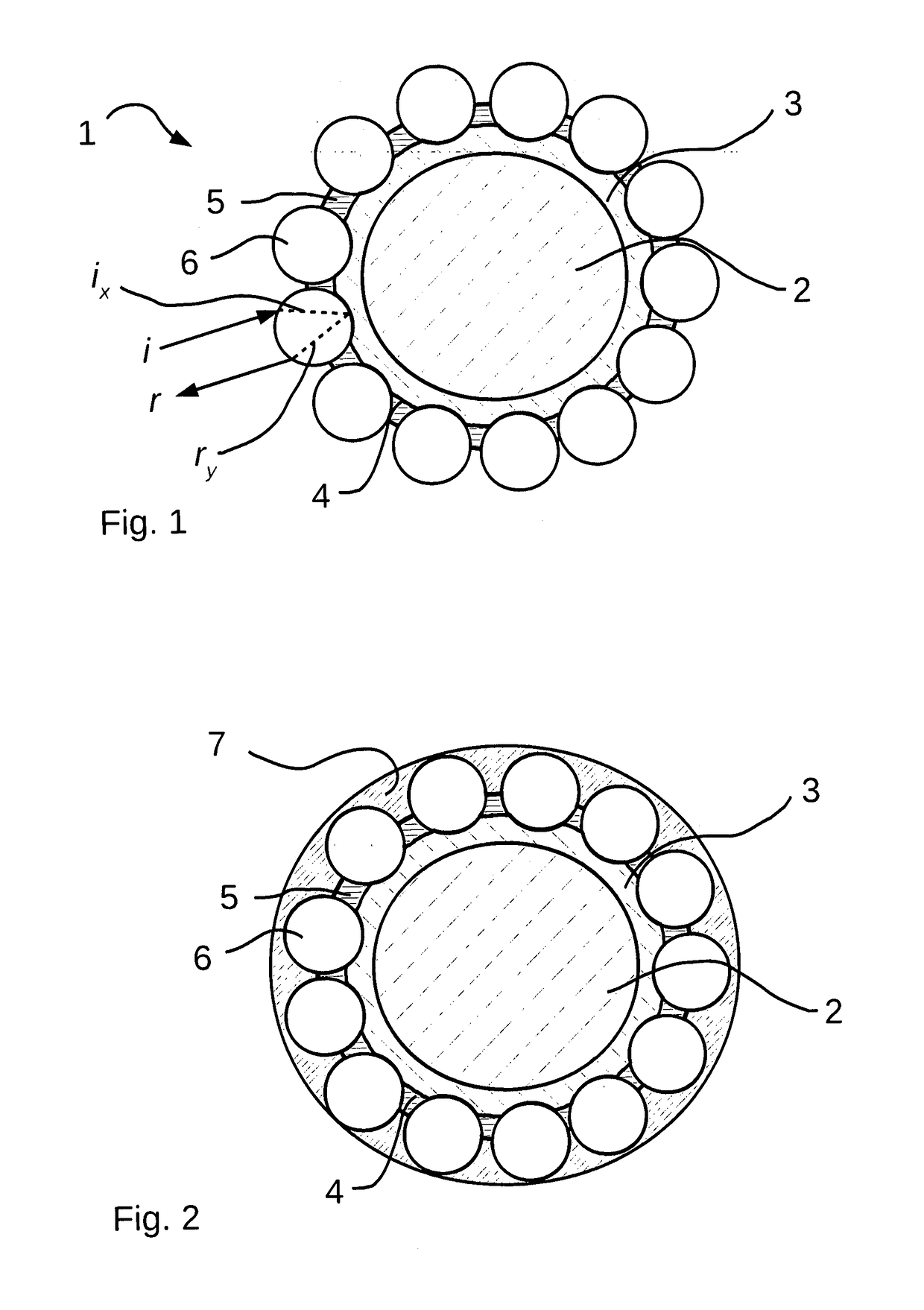Retroreflective, elongated, filamentous product, process for making the same, uses thereof and products made therefrom
a technology of retroreflective and filamentous products, applied in the field of yarns, can solve the problems of difficult weaving of filament into textile products, relatively complex system, and difficulty in weaving through the method
- Summary
- Abstract
- Description
- Claims
- Application Information
AI Technical Summary
Benefits of technology
Problems solved by technology
Method used
Image
Examples
example 1
[0107]A high tenacity PA66 multifilament yarn of 110 dTex was drawn (10) at 20 m / min with a constant tension of 20 cN into a first vessel containing a crosslinkable formulation (11) as indicated in Table 1.1, and then dried in an infrared oven (12) at no more than 110° C. degrees for 20 seconds. The formulation of Table 1.1 was applied to the core yarn by total immersion of the yarn in a crosslinkable formulation bath, drawing it through the bath via a convoluted yarn path. This enabled the crosslinkable formulation to be applied between the filaments and onto the yarn surface, thereby improving adhesion and homogeneity of the formulation. The thus impregnated yarn was then passed over the surface of a motorized rotary roller, comprising one or more grooves provided in the surface of the roller, for example, by engraving, the grooves being aligned along the direction of travel of the yarn. The motorized rotary roller had a linear speed of 0.9 metres / min, and the groove or grooves a ...
coloured yarn example 1
[0128]In a different embodiment of Example 1, a load of 15 parts per hundred of the blue pigment, C.I. P.Blue 15:3 with 46% dry content, was added only to the second polymer matrix primer layer formulation in Table 1.3. The yarn was manufactured exactly as for the “open lens” example above, before and after application of the second polymer matrix primer layer. Yarn linear mass density and diameter were unchanged. The weight fractions scale up appropriately in the second polymer matrix primer layer. Since the mass ratio between the primer layer and the first polymer matrix layer is around 5 / 95, pigment contribution is less than 0.5% in the coatings, and negligible in total. The yarn had an intense blue colour under diffuse illumination. RA dropped down to 50 cd / lux / m2 for the yarn wrapped around a flat spool, which is 66% of the value observed for the unpigmented yarn.
[0129]A careful positioning of the pigmented layer, in this case behind the refractive microparticles, and yet still...
example 2
[0131]The PA66 110 dtex high-tenacity yarn was processed as for Example 1 until just before application of the second polymer matrix primer layer. The coated and dried yarn entered the vessel containing the second polymer matrix primer layer formulation as defined in Table 2.1.
TABLE 2.1second polymer matrix primer layer formulation for embedded microparticleretroreflective yarnNameDescription / usageParts per hundred (phr)Witcobond 737 (Baxenden Chem.Polyurethane dispersion adhesive100LTD.)(solid content 40%)Water (Deionized)Diluent20Trixene AQUA BI 201Blocked Isocyanate Crosslinker3Acusol 820 (DOW Europe GmbH)Thickener0.5BYK 093 (BYK Additives,Defoamer0.4ALTANA Group)BYK 349 (BYK Additives,Wetting agent0.2ALTANA Group)Gamma-Adhesion promoter1glycidoxypropyltrimethoxysilaneAmmonium hydroxide (as 5% NH3pH modifying agentQuantum sufficit for pH >7solution in water)
[0132]The primer layer wet content on the yarn was calibrated via the same applicator system with motorized rotary roller an...
PUM
| Property | Measurement | Unit |
|---|---|---|
| thickness | aaaaa | aaaaa |
| thickness | aaaaa | aaaaa |
| thickness | aaaaa | aaaaa |
Abstract
Description
Claims
Application Information
 Login to View More
Login to View More - R&D
- Intellectual Property
- Life Sciences
- Materials
- Tech Scout
- Unparalleled Data Quality
- Higher Quality Content
- 60% Fewer Hallucinations
Browse by: Latest US Patents, China's latest patents, Technical Efficacy Thesaurus, Application Domain, Technology Topic, Popular Technical Reports.
© 2025 PatSnap. All rights reserved.Legal|Privacy policy|Modern Slavery Act Transparency Statement|Sitemap|About US| Contact US: help@patsnap.com



